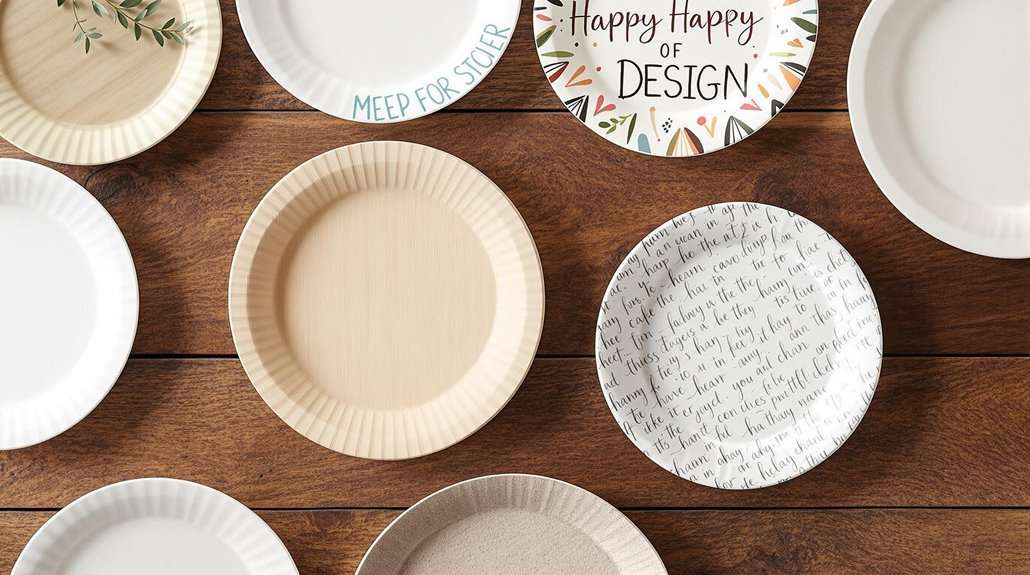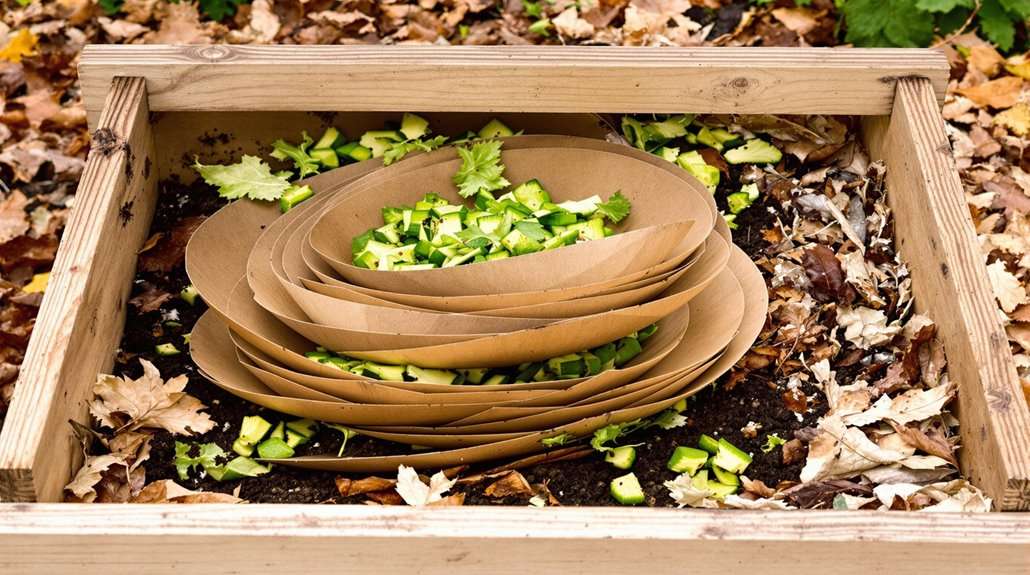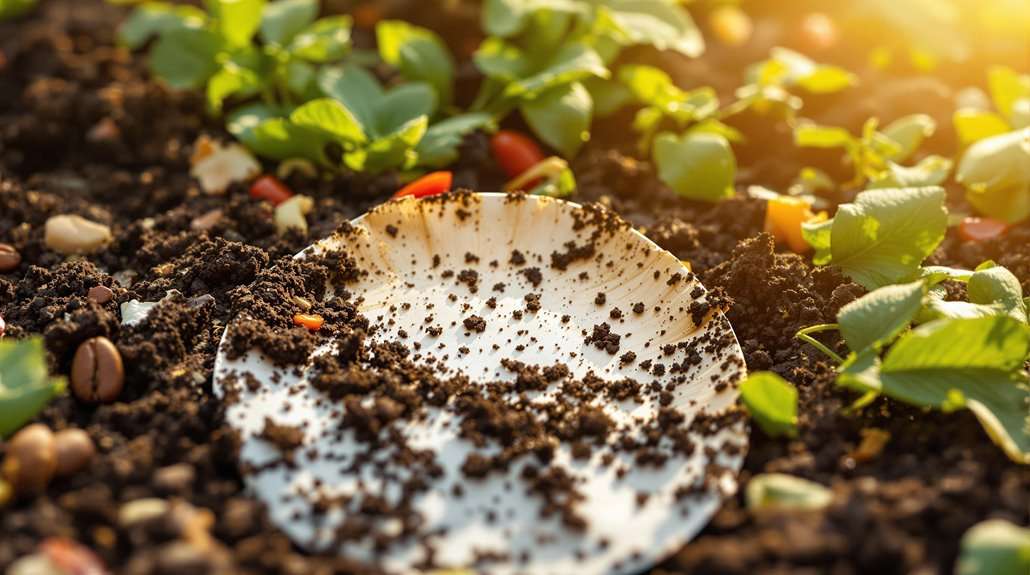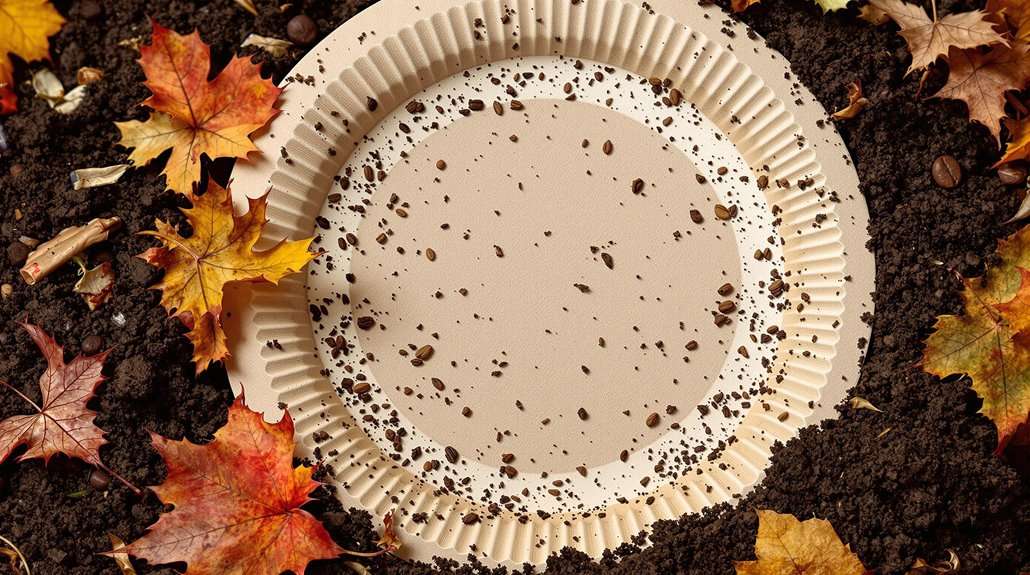Can You Compost Paper Plates
You can compost plain, uncoated paper plates in your home compost bin, but you'll need to be selective about which types you add. Natural fiber plates without chemical treatments or coatings will break down within 1-3 months, while wax-coated or plastic-lined plates won't decompose properly and should go in the trash. For successful composting, tear the plates into smaller pieces and mix them with "brown" materials like leaves or straw. Remember to check for certifications like BPI or ASTM D6400 to verify your plates are truly compostable. Understanding the specific types and proper techniques will help maximize your composting success.
This post may contain affiliate links. If you make a purchase through these links, I may earn a commission at no additional cost to you. Additionally, portions of this post may be generated using artificial intelligence (AI) technology. While we strive for accuracy, please be aware that AI-generated content may not always be perfect and should be fact-checked when necessary.
The Spatula Scoops
- Plain, uncoated paper plates can be composted easily, breaking down within 1-3 months in proper composting conditions.
- Plates with plastic, wax, or chemical coatings should not be composted as they won't break down properly.
- Look for certified compostable labels like BPI or ASTM D6400 to ensure plates will decompose without harmful residues.
- Shredding paper plates into smaller pieces before adding them to compost helps speed up the decomposition process.
- Mix paper plates with both "brown" materials like leaves and "green" materials like food scraps for optimal composting.
Types of Paper Plates

Among the various disposable dining options, paper plates come in four main categories: compostable, coated, sugarcane-based, and standard varieties. You'll find that each type serves different purposes and offers distinct environmental impacts.
Compostable paper plates, crafted from sustainable plant-based resources, are available in multiple sizes, including 6-inch appetizer plates and 10-inch compartmented options. They're specifically designed for processing in commercial and municipal composting facilities. Coated paper plates, while more durable and resistant to liquids and grease, aren't compostable due to their waterproof layer, but you'll find them in convenient 7, 9, and 10-inch sizes. Leading brands like Dixie Ultra offer plates that are 3x stronger than store brands.
Sugarcane-based plates, also known as bagasse plates, offer an eco-friendly alternative that's both biodegradable and microwave-safe. They're made from the leftover fiber after sugarcane juice extraction, providing excellent durability for wet and greasy foods. Standard paper plates, while typically the most economical choice, are less durable and tend to become soggy with wet foods. You should note that if they're coated or laminated, they won't be suitable for composting, though they're readily available in common 7 and 9-inch sizes.
What Makes Paper Plates Compostable
When you're looking to compost paper plates, the type of coating plays an essential role in determining whether they'll break down naturally. You'll find that untreated, natural paper plates without chemical additives, dyes, or poly-coatings are your best options for composting. While plain paper plates can decompose readily, those treated with moisture-resistant chemicals, bleach, or printing inks won't break down properly in either home or commercial composting systems. Look for plates that are BPI certified to ensure they meet proper composting standards.
Coating Types Matter Most
Since the coating determines whether a paper plate can break down naturally, understanding different coating types is crucial for successful composting. You'll find that most paper plates in the market feature either compostable or non-compostable coatings, with each type notably impacting their environmental footprint. When examining your paper plates, look for products coated with plant-based materials or water-based solutions, as these break down readily in composting conditions. Emerging water-based coatings are increasingly popular in today's market.
- Polylactic Acid (PLA) coatings will decompose in industrial composting facilities where high heat and moisture levels are maintained.
- Polyhydroxyalkanoates (PHAs) offer biodegradable properties but require specific composting conditions.
- Water-based coatings represent the newest technology, providing both compostability and recyclability.
- Plant-based coatings derived from sugarcane or bamboo offer petroleum-free alternatives.
You'll want to avoid plates with polyethylene, PFAS, or wax coatings, as these materials contaminate compost piles and don't break down naturally. Instead, opt for plates certified under ASTM D6400 standards for industrial composting. These certifications guarantee your paper plates will decompose completely without leaving harmful residues in the finished compost.
Natural vs. Treated Paper
The fundamental composition of paper plates determines their compostability, with naturally sourced materials breaking down far more efficiently than treated ones. You'll find that plates made from unbleached, natural fibers like bamboo and sugarcane bagasse decompose readily, while those containing synthetic treatments pose significant challenges to the composting process. Modern eco-friendly plates are microwave safe (248°F) while maintaining their composting properties.
| Material Type | Composting Time | Environmental Impact |
|---|---|---|
| Natural Fiber | 1-3 months | Minimal residue |
| Wax-Coated | 6-12 months | Leaves wax residue |
| Plastic-Lined | Won't decompose | Contaminates soil |
When you're selecting compostable plates, look for products that carry ASTM D6400 or D6868 certifications, as these guarantee the absence of harmful coatings. Natural paper plates, made from sustainable resources without bleach or dyes, will break down completely in commercial composting facilities within 1-6 months. They're also stronger than you might expect, capable of handling both hot and cold foods without the need for synthetic reinforcement. Remember that even naturally sourced plates may require specific composting conditions, so it is crucial to verify whether your local facilities accept these materials.
Chemical-Free Paper Requirements
Creating truly compostable paper plates requires strict adherence to chemical-free production standards. When you're looking for compostable paper plates, you'll need to guarantee they're made without harmful substances like chlorine, bleach, or PFAS chemicals. The plates must use natural, plant-based materials such as bamboo, sugarcane bagasse, or other sustainable fibers that don't contribute to deforestation.
These plates provide leak-resistant performance even without chemical additives, making them suitable for both hot and cold foods. For paper plates to be genuinely compostable, they must meet several essential requirements:
- Materials must come from renewable resources like bamboo or sugarcane bagasse, avoiding wood pulp entirely
- Coatings must be non-toxic and free from petroleum-based substances, waxes, or harmful chemicals
- Manufacturing processes can't include synthetic additives, dyes, or preservatives
- Products must hold valid BPI certification and meet ASTM D6400 standards for compostability
The absence of chemicals guarantees these plates will break down safely within 90 days in commercial composting facilities, leaving no toxic residues behind. Remember, proper chemical-free production isn't just about what's left out – it's about carefully selecting sustainable materials that naturally provide the strength and functionality you need without compromising environmental safety.
Home Composting Methods

Successful home composting begins with choosing the right system and following proper layering techniques. You'll want to start with enclosed bins or tumblers, which are ideal for urban settings as they prevent pest problems and contain odors. If you're building your own system, you can use wire mesh or wooden pallets, or opt for a three-chambered bin that allows for continuous composting. Making sure to establish the proper mix of browns and greens is essential for optimal decomposition.
To create an effective compost pile, you'll need to layer your materials carefully. Begin with a 4- to 6-inch foundation of bulky browns like twigs and wood chips. Then, alternate between your brown materials (dry leaves, straw, and sawdust pellets) and green materials (food scraps, grass clippings, and coffee grounds), maintaining a ratio of 2-3 parts browns to 1 part greens. Keep your pile moist but not waterlogged, and turn it regularly to maintain proper oxygen flow. While you're adding materials, remember to crush eggshells before including them, and avoid adding paper plates, as they often contain non-compostable coatings. Your compost pile should maintain a temperature around 130-140°F to effectively break down materials and eliminate pathogens.
Commercial Composting Facilities
When you're looking to compost paper plates through commercial facilities, you'll need to understand that they use specialized industrial equipment and follow strict ASTM D6400 and D6868 standards for processing compostable materials. These facilities can break down certified compostable plates within 90 days using controlled temperature, moisture, and microbial conditions that aren't achievable in backyard setups. Since commercial composting facilities aren't available everywhere, you should check with your local waste management services to find the nearest location that accepts compostable materials. Many sustainable plates are made from unbleached plant fiber that aligns perfectly with commercial composting requirements.
Processing Time and Methods
Commercial composting facilities offer three key advantages for processing paper plates: higher temperatures, consistent aeration, and specialized technology. These facilities maintain ideal conditions of 140°F or higher, which greatly speeds up decomposition compared to home composting. You'll find that their industrial-scale operations can process your paper plates in just 5 to 6 months, thanks to their advanced equipment and controlled environments. Products like Dixie Ultra® tableware are BPI® certified for commercial composting, ensuring proper decomposition in these facilities.
- Remove all food residue and non-compostable materials before sending plates for processing
- Make sure your plates aren't coated with plastic or other synthetic materials
- Check if your local facility accepts paper plates specifically
- Consider shredding plates beforehand to accelerate the process
When you're working with a commercial facility, they'll handle the technical aspects of separating any inorganic chemicals from the paper pulp. This separation process is essential for producing high-quality compost that's safe for soil enrichment. While not everyone has access to commercial composting facilities, they're your best option for processing paper plates efficiently, especially if you're dealing with specialized compostable materials like PLA-coated plates that require specific conditions to break down properly.
Required Equipment and Standards
Professional composting facilities must adhere to strict international standards and maintain specific equipment to process paper plates effectively. These facilities follow standards like ASTM D6400 and EN 13432, which require 90% biodegradation within 180 days and complete disintegration within 12 weeks. The TÜV Austria certification validates these standards through rigorous third-party testing.
You'll find that commercial facilities use sophisticated equipment to maintain ideal composting conditions. They're equipped with advanced aeration systems that control temperature and oxygen levels, keeping the environment above 50°C to speed up decomposition. Continuous monitoring systems track humidity and aeration conditions, while specialized processing machinery turns and mixes the compost piles for uniform breakdown.
To guarantee compliance, facilities must conduct regular testing for biodegradation, disintegration, and toxicity. Your paper plates need to break down into pieces smaller than 2mm and shouldn't contain any hazardous substances. The facilities you're working with should be certified by recognized bodies like BPI or CMA, and they'll use proper labeling to verify their certification status. These standards and equipment requirements help ensure that when you're composting paper plates, they're being processed safely and efficiently in a controlled environment.
Facility Location and Access
Widely accessible composting facilities exist across North America, with major operators like Walker Industries and GFL Environmental managing extensive networks of processing sites. You'll find various facility types available, from large-scale commercial operations to municipal programs, each offering different services for organic waste processing. The facility in Thorold processes over 65,000 tonnes annually of organic materials through their specialized operations.
To locate a composting facility near you that accepts paper plates, you can:
- Use BPI's Find A Composter search tool to identify facilities by location and accepted materials
- Contact your local waste management authority, like Ottawa Valley Waste Recovery Centre, for municipal composting options
- Check with commercial operators like GFL Environmental for business collection services
- Visit municipal facilities, such as Barrie's landfill site, which often sell finished compost to residents
Many facilities offer convenient drop-off locations and scheduled collection services to accommodate your needs. For instance, Walker Industries' 12-acre facility in Thorold accepts organic materials from multiple sources, while GFL Environmental provides customized collection schedules for businesses. When choosing a facility, consider factors like distance, accepted materials, and whether they offer collection services or require drop-off.
Environmental Benefits

Along with its practical advantages, composting paper plates delivers significant environmental benefits that help protect our planet's resources and reduce waste. When you compost your paper plates, you're helping to conserve valuable landfill space while creating nutrient-rich soil that reduces the need for synthetic fertilizers. Products like Hefty's line use 50% recovered materials in their manufacturing process to further minimize environmental impact.
| Environmental Benefit | Impact |
|---|---|
| Greenhouse Gas Reduction | Prevents methane production in landfills |
| Resource Conservation | Reduces demand for virgin materials |
| Pollution Prevention | Minimizes microplastic contamination |
| Sustainable Production | Supports circular economy practices |
You'll also be contributing to the reduction of greenhouse gas emissions, as composting facilities emit less carbon dioxide compared to landfills. When paper plates decompose naturally in a composting environment, they break down without leaving harmful residues, unlike their non-biodegradable counterparts. Additionally, by choosing compostable plates made from renewable resources like sugarcane fiber or bamboo, you're supporting sustainable production methods that minimize environmental impact during manufacturing. The composting process creates a closed-loop system where your waste becomes a valuable resource, promoting a more sustainable future for generations to come.
Common Composting Mistakes
Successful composting requires avoiding several common pitfalls that can derail your efforts. When composting paper plates or any other materials, you'll need to maintain proper moisture levels and guarantee adequate aeration throughout your pile. A well-balanced compost heap should feel as damp as a wrung-out sponge, not soggy or bone dry. Following the lasagna-style layering method can help prevent odors and ensure proper decomposition.
- Don't add non-compostable materials like meat, dairy, or chemically treated items, as these can attract pests and create unpleasant odors
- Avoid overloading your pile with too many nitrogen-rich materials (greens) without balancing them with carbon-rich materials (browns)
- Never include diseased plants or weeds with seeds, as these can spread problems throughout your garden
- Make sure you're turning your pile regularly to maintain proper oxygen levels and prevent anaerobic conditions
To maintain the ideal carbon-to-nitrogen ratio of 25-30:1, you'll need to carefully balance your green and brown materials. If your pile becomes too wet, add more browns like paper or leaves. If it's too dry, add some water and green materials. Remember to place your compost bin in a location that receives adequate sunlight and has good drainage.
Best Composting Practices

Understanding best composting practices starts with identifying the right materials for your compost pile. You'll want to check if your paper plates are truly compostable by looking for certifications like BPI and examining the manufacturer's claims about biodegradability. Most disposable plates end in landfills, making proper material identification crucial. If you're using plant-based plates made from bamboo, sugarcane, or palm leaves, you're on the right track.
To enhance your composting process, cut or shred your plates into smaller pieces before adding them to your bin. You'll need to maintain proper moisture levels and guarantee adequate oxygen flow throughout your pile. While commercial facilities can break down compostable plates within 1-6 months, home composting may take longer, so patience is essential. It's also important to store food waste at the ideal refrigerator temperature of refrigerator storage temperature to prevent bacterial growth before adding it to your compost.
Keep your compost bin free from contamination by carefully sorting materials and removing any plates with poly coatings or chemical treatments. Remember that ideal decomposition requires regular maintenance of your compost pile. By following these practices, you'll create nutrient-rich soil while supporting sustainable agriculture and reducing landfill waste. When in doubt about a plate's compostability, err on the side of caution and dispose of it through alternative means.
Alternative Eco-Friendly Plate Options
When considering alternatives to traditional disposable plates, you'll find several eco-friendly options that align with sustainable practices. Compostable plates made from sugarcane bagasse, bamboo, and palm leaves offer significant environmental benefits while reducing your carbon footprint. These materials break down naturally in composting facilities and can enrich soil health without leaving behind harmful microplastics. Certified compostable plates decompose much faster than conventional paper plates with coatings.
- Sugarcane bagasse plates utilize agricultural waste products, making them an excellent choice for environmentally conscious consumers
- Bamboo plates provide durability and can withstand multiple uses before composting
- Palm leaf plates offer a natural, biodegradable option that requires minimal processing
- Tree-free plates help combat deforestation while meeting your dining needs
You'll find these sustainable alternatives particularly beneficial if you're running a business, as they can reduce waste management costs and enhance your brand's reputation. When shopping for eco-friendly plates, look for certified compostable labels to guarantee they meet strict decomposition standards. While reusable plates remain the most environmentally sound choice, these compostable options provide a practical solution when disposable serviceware is necessary.
Frequently Asked Questions
Do Coffee Stains on Paper Plates Affect Their Compostability?
Coffee stains won't affect your paper plate's compostability, as long as the plate itself is uncoated and chemical-free. What matters most is the plate's base material, not the stains. You'll find that plant-based plates, like those made from sugarcane or bamboo, remain fully compostable even with coffee stains. However, if your plates have poly coatings or special moisture-resistant treatments, they won't break down properly, regardless of stains.
Can Paper Plates Contaminated With Mold Still Be Composted?
Like unwanted houseguests, moldy paper plates don't have to be turned away from your compost pile. You can safely compost them, as the high temperatures in a well-maintained pile will break down both the mold and plate material. However, you'll need to maintain proper balance by mixing these damp, contaminated plates with dry materials like leaves or straw. Always bury moldy items in the center of your pile's hot zone.
How Many Paper Plates Can I Add to Compost Weekly?
While there's no strict weekly limit for adding paper plates to your compost, you'll want to maintain a balance. For home composting, add 3-5 plates per week as part of your "brown" materials, ensuring they're mixed with plenty of "green" materials like food scraps. If you're using a commercial facility, you can add more, but it's best to check their specific guidelines for acceptable quantities and types.
Will Composting Paper Plates Attract Rodents to My Backyard?
Studies show that properly managed compost piles have less than a 5% chance of attracting rodents. You won't attract rodents when composting paper plates if you're following good practices: maintain a balanced mix of browns and greens, keep your pile moist but not wet, turn it regularly, and use a rodent-proof bin with secure lid. If you're worried, shred your plates and bury them in the center of your pile.
Should Paper Plates Be Shredded Before Adding to Compost Bins?
Yes, you should definitely shred paper plates before adding them to your compost bin. Shredding optimizes decomposition by creating smaller pieces that break down faster and allow better oxygen flow throughout your pile. You'll find that shredded plates distribute carbon more evenly and create helpful air pockets. They'll also absorb excess moisture effectively, which helps maintain the right composting conditions. Remember to remove any food waste and greasy residue first.





